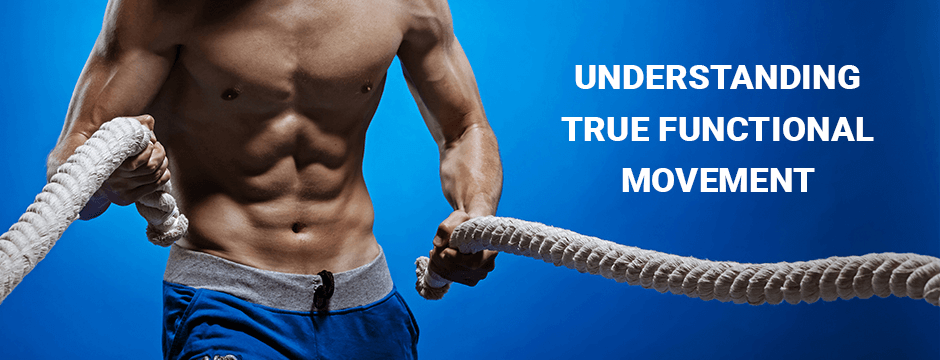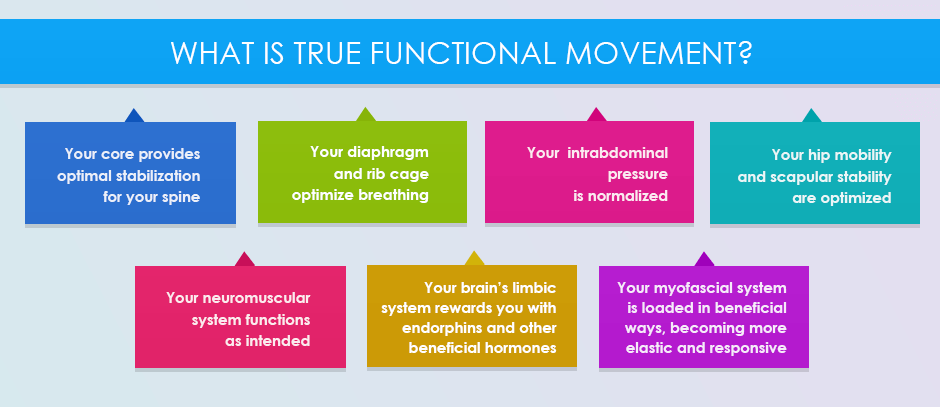
Most workout routines approach training by dividing the body into individual muscles or muscle groups, and assigning linear exercises that isolate those areas. While muscle-specific exercises have value in terms of toning, strengthening and increasing muscle mass, they overlook the interconnected and interdependent nature of the body’s structures as a whole. In many cases, we are performing high-level exercises while ignoring fundamental motor deficits, and attempting to add fitness to dysfunction.
Functional training exercises seek to bridge the gap by performing compound exercises using body weight or multi-planar resistance. But in many cases, functional training exercises are not truly functional, because they fail to take into consideration the ways your body needs to coordinate movements in different planes, to make truly functional gains. In essence, we are building muscle without enhancing movement.
Understanding the underlying principles of true functional movement will help trainers, therapists and fitness enthusiasts to create training programs that promote functional changes for more fluid movement and reduced risk of injury.
Muscle imbalances, restrictions in mobility and problems with balance and stability are common consequences of modern sedentary lifestyles. Most people ignore them until they begin to cause pain, and then treat the pain until it becomes unbearable. In active and athletic populations, the same issues arise, often due to overuse, or to past injuries that were never fully rehabilitated.
Going to a conventional medical doctor rarely resolves the problem, since few MDs have any understanding of dynamic movement, and most are prohibited by insurance providers from treating anything beyond the painful area. Instead, you end up with prescriptions for pain and anti-inflammatory medications, with instructions to rest and take it easy.

Treating the symptoms of mobility issues does nothing to resolve them, and they soon become a downward spiral that leads to injury and disability. Functional movement therapy seeks to resolve pain and dysfunction by identifying and correcting the underlying causes, to restore fluid and pain-free movement.
In his book, Movement, physical therapist and athletic conditioning expert Gray Cook defines 10 underlying principles of functional movement.
True functional movement takes into account the integration of your body’s structures and systems, to produce coordinated movement patterns that reduce pain and enhance performance. When your upper and lower body coordinate, and your right and left appendages move with identical forces, joint angles and range of motion, your entire body is affected.

Before we can optimize movement, we need to address pain. Once pain is eliminated, we can then proceed to work on proprioception, alignment, stability and muscle activation patterns.
When your upper and lower body are moving in different planes, your spinal stabilizers, core muscles, pelvic region and shoulder girdle need to coordinate their movements in an integrated way. You may recall from high school geometry that a plane is like a flat sheet of glass that extends to infinity in all directions.

All human movement occurs in three planes of motion:
The sagittal plane runs perpendicular to gravity and divides your body into right and left segments. Flexion and extension occur in the sagittal plane.
The frontal plane also runs perpendicular to gravity and divides your body into posterior and anterior segments. Abduction and adduction occur in the frontal plane.
The transverse plane runs parallel to gravity, and divides your body into lower and upper segments. Rotation takes place in the transverse plane.
Throughout the walking and running gait cycles, different segments of your body move in all three planes of motion. Coordinating motion in multiple planes requires specific muscle recruitment and firing patterns, as well as synchronicity of motion between the left and right sides of your body.
When your movements are not coordinated, you reduce your body’s overall performance and increase your risk of injury.
Once we weed out compensation patterns and dysfunctional motor patterns, we can move forward to the restorative phase of rehab. Once functional movement is restored, we can then enhance fitness and optimize performance.
Passive physical therapy deprives patients of the benefits of dynamic movement. And after all, movement is life! But progressing a patient from passive care to active, and progressing beyond active care to freedom of motion, takes knowledge, skill and experience.
At NYDNRehab, we use quantitative data gathered during the assessment process as a baseline, and closely monitor each patient’s progress toward full functional movement.
Some of our functional movement treatment tools include:
If you want to move freely without pain and explore your peak performance potential, contact NYDNRehab today, and get moving toward a better, more active quality of life.
Resources:
Cook, Gray. Movement: Functional movement systems: Screening, assessment, corrective strategies. On Target Publications, 2010.
Cook, Gray, et al. “Functional movement screening: the use of fundamental movements as an assessment of function-part 1.” International journal of sports physical therapy 9.3 (2014).
Dr. Lev Kalika is a world-recognized expert in musculoskeletal medicine. with 20+ years of clinical experience in diagnostic musculoskeletal ultrasonography, rehabilitative sports medicine and conservative orthopedics. In addition to operating his clinical practice in Manhattan, he regularly publishes peer-reviewed research on ultrasound-guided therapies and procedures. He serves as a peer reviewer for Springer Nature.
Dr. Kalika is an esteemed member of multiple professional organizations, including: